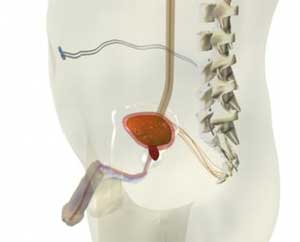
 |
 |

|
|
Q: How does the bladder stimulator work? A: The Implanted Bladder Stimulator allows you to control your bladder using an electrical device. This system includes a stimulator that is placed under the skin of your belly that is similar to a heart pacemaker. Q: Can anyone use this approach? A: Not everyone can use this approach. In order to use the bladder stimulator the person must be able to transfer onto a toilet. They must also have a reflexive bladder, one that squeezes when it gets full.
Q: Are many people using this approach? A: The bladder stimulator surgical approach to bladder management is quite sophisticated. It is used by over 1000 people in Europe and about a hundred and fifty more in the U.S. The FDA approved this approach in 2001. Most insurance companies will pay for the costs of installation and management.
Q: Are there any problems with using this bladder management approach?? A: The biggest problem with this approach is that it requires a fairly major operation to implant the device. Generally people are hospitalized for 4 days for the implant and need to be off their usual routine for about 2 weeks. |

